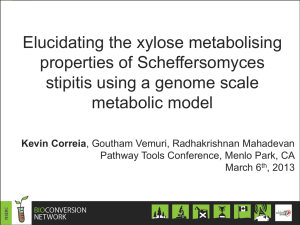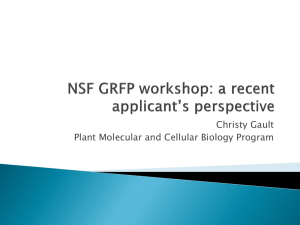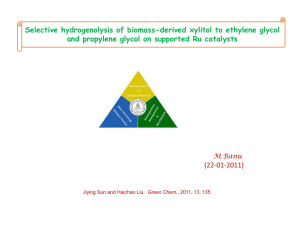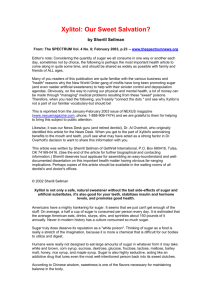GB 12487—×××× 1 GB 13509-×××× Preface The technical
advertisement
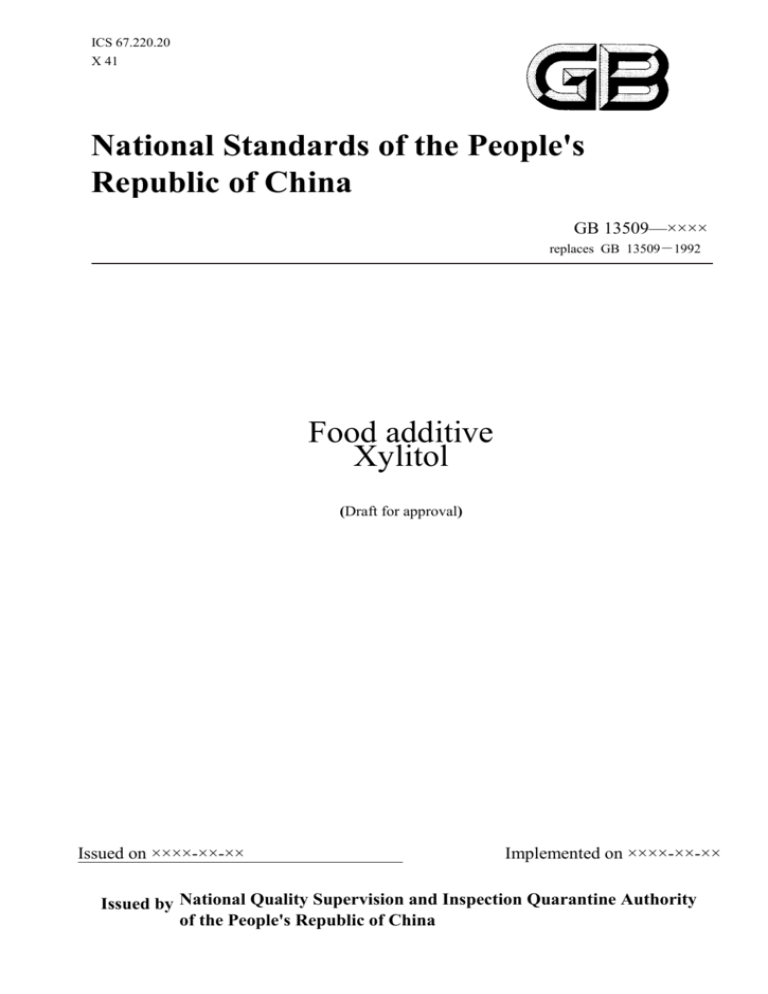
ICS 67.220.20 X 41 National Standards of the People's Republic of China GB 13509—×××× replaces GB 13509-1992 Food additive Xylitol (Draft for approval) Issued on ××××-××-×× Implemented on ××××-××-×× Issued by National Quality Supervision and Inspection Quarantine Authority of the People's Republic of China GB 13509-×××× Preface The technical requirements in Chapter 4 of the Standards are mandatory and the others are voluntary. The technical requirements of the Standards are the MOD of "The Food-grade Chemical Products Code of the United States (FCC IV, 1996)". The standards is a revision to GB 13509-1992 "Food Addictive Xylitol" The differences between the Standards and GB 13509--1992 are as follows: ──Cancel the index of total alcohol content in the index of physical and chemical properties and add the index of lead content ──Increase the index of xylitol content, control the index of loss on drying, other polyols and reducing sugar strictly and modify the index of melting point. ──The methods of xylitol content test include GLC (gas liquid chromatography) and HPLC (high performance liquid chromatography). The Standards was proposed by National Light Industry Association of China. The Standards is under the jurisdiction of National Centre of Food & Fermentant Standardization. The Standards is drafted by Hebei Baoshuo Co., Ltd. Xyfur Branch, Shangdong Yucheng Futian Pharmaceutical Co., Ltd, Xylitol Factory of Henan Huixian Hongtai Chemistry Industry Co., Ltd, Beijing Jianli Pharmaceutical Co., Ltd, Zhejiang Kaihua Huakang Pharmaceutical Factory and China National Academy of Food & Fermentant Industries. The Standards is drafted by Wu Jibiao, Zhu Lujia, Lu Zhinuan, Wangping and Li Huiyi. The Standards was first issued in 1992. The issuance of all previous versions replaced by the Standards is as follows: ──GB 13509-1992. I GB 13509-×××× Food Additive Xylitol 1 Scope The Standards specifies technical requirements, test methods and detection rules of xylitol. The Standards is applicable to food additive products that take agriculture products, such as corncob and bagasse, as materials and then be processed through technical progresses, such as hydrolyzation, purification and hydrogenation. 2 Normative reference The following documents contain provision which, through reference in this text, constitute provisions of the Standards. For dated references, subsequent amendments (do not include corrigendum) or revisions of these publications are not applicable to the Standards. Parties to agreements based on the Standards are encouraged to investigate the possibility of applying the most recent editions of the standards. For undated references, the latest edition of the normative document referred to applies. GB 6678---1986 General sampling principles of chemical products (nep ASTM E300: 1983) GB/T 6682—1992 Water specification and test method in analytic laboratory (nep ISO 3696: 1987) GB 8449—1987 Test method for lead in food additive GB 8449—1987 Test method for arsenic in food additive GB 8449—1987 Test method for heavy metal limit in food additive 3 Molecular formula, relative molecular mass and structural formula Molecular formula: C5H12O5 Relative molecular mass: 152.15 (refer to International Atomic Mass Table, 1991) Structure formula: CH2OH H C OH HO C H H C OH CH2OH 1 GB 13509-×××× 4 Technical requirements 4.1 Appearance and sense It is odourless white crystalline powder with a sweet taste. It is freely soluble in water, sparingly soluble in methyl alcohol or ethyl alcohol. 4.2 Physical and chemical index It is detailed in table 1. Table 1 Physical and chemical index Item Index Assay (as anhydrous basis), % 98.5-101.0 Melting point, °C 92.0-96.0 Other polyols, % ≤ 2.0 Loss on drying, % ≤ 0.50 Residue on burning, % ≤ 0.50 Reducing sugar (as glucose), % ≤ 0.20 Arsenic (as As), % ≤ 0.0003 Heavy metal (as Pb), % ≤ 0.0010 Lead, % ≤ 0.0001 5 Test method If there is no special requirement, the reagents used in the Standards are AR (analytical reagent) and water used in the Standards have use-specification of Grade 3 or above set in GB/T 6682—1992. 5.1 Identification Dissolve 5g samples in 10ml solvent (hydrochloric acid: formaldehyde = 1). React for 2h at 50°C. Add 25ml ethyl alcohol in this reactant, collect the formed crystal, heat it to dissolve in 10ml water, add 50ml ethyl alcohol, filter and then collect the separated crystal. Recrystallize with ethyl alcohol twice and dry at 105°C for 2h, mp 195.0°C-201.0°C. 5.2 Assay and other polyols 5.2.1 GC (gas liquid chromatography) 5.2.1.1 Method overview When the sample is injected into column, the xylitol is separated from other components because the adsorption coefficient of components in the gas phase and liquid phase is different. Use hydrogen flame--ionisation detector to make detection and compare the results with standard sample. Make qualitative analysis according to retention time and make quantitative analysis by using internal standard method. 5.2.1.2 Instruments a) GC: hydrogen flame-ionisation detector b) Microsyringe 5.2.1.3 Assay 5.2.1.3.1 Reagent a) Octadecane: HPLC; 2 GB 13509-×××× b) Heptane; c) Pyridine (GB 689); d) HMDS (hexamethyldisiloxane); e) TMCS (trimethylchlorosilane); f) Standard xylitol. 5.2.1.3.2 Chromatographic conditions a) Chromatography column: φ3x2000mm glass column or stainless steel column. b) Stationary phase: attach 20% poly methyl silicone on chromosorb WAW-DMCS (60-80 mesh). c) Carrier gas:Concentrated nitrogen, flow rate: 50-60ml/min or adjust it to a certain value in that condition the Xylitol’s TMS peak can appear in 13min after injecting sample. d) Air velocity: 600ml/min. e) Column temperature: 190°C. f) Detector temperature: 250°C. h) Injector port temperature: 250°C. Make test to choose the optimum chromatographic conditions according to different instruments. 5.2.1.3.3 Test method a) Internal standard solution: Weigh octadecane 500mg (accuracy to 0.0001g), dissolve in heptane, pour the solution into a 25ml Volumetric flask, dilute it to volume and then mix thoroughly. b) Standard Preparation: Accurately weigh standard xylitol 50mg (accuracy to 0.0001g), pour into a 25ml volumetric flask, add 1ml pyridine, dissolve with steam heating, cool it to the room temperature, add 0.2ml HMDS and 0.1ml TMCS in the volumetric flask. Keep for 30min under room temperature, then add 5.0ml internal standard solution, and dilute it to volume with heptane. Shake thoroughly. b) Sample Preparation: Accurately weigh 50mg sample of dry residue (accuracy to 0.0001g), pour into a 25ml volumetric flask, add 1ml pyridine, dissolve with steam heating, cool it to room temperature, add 0.2ml HMDS and 0.1ml TMCS in the volumetric flask, keep for 30min under room temperature, then add 5.0ml internal standard solution (5.2.1.3.3a), and dilute it to volume with heptane. Shake thoroughly. d) Inject 10μL solution of standard preparation into column,record TMS peak area of xylitol (Ax) and TMS peak area of octadecane (Ax). 5.2.1.3.4 Calculation RR Ax Co Ao C x ……………………………………(1) Where: RR── the response ratio, of xylitol Co── Concentration of octadecane in solution of standard preparation (mg/ml) Cx── Concentration of xylitol in solution of standard preparation (mg/ml) Similarly, inject 10μL solution of standard preparation into column, record TMS peak area of xylitol (ax) and TMS peak area of octadecane (ao). Assay of xylidol is calculated by formula (2): 3 GB 13509-×××× X a x Co 25 100% ao RR m ……………………………………(2) Where: X---- the assay of xylitol m── the weight, in mg, of sample of dry residue 5.2.1.3.5 Allowable difference Assay of xylitol: The relative standard deviation must be within 0.2%. Take the average value as the result. 5.2.1.4 Other polyols 5.2.1.4.1 Reagent a) Standard Mixture: Accurately weigh 25mg mannitol, galactitol, arabinitol and sorbitol, and Reference Standard xylitol 100mg. Pour into 10mL volumetric flasks respectively. Add 0.2mL anhydrous pyridine and 1mL acetic anhydride in each flask. Heat flasks on the hot plate for 30min (heat slowly to prevent solution again boiling). After cooling, dilute mannitol, galactitol, arabinitol and sorbitol to the mark with acetone. Accurately pipet 0.2mL mannitol and 0.2mL sorbitol solution, 0.08mL arabinitol and 0.08mL galactitol solution and then pour them into the Reference Standard flask of galactitol. Dilute it to the mark with acetone. Shake thoroughly. b) Test Preparation: Accurately weigh 100mg sample (accuracy to 0.0001g) and pour into a 10ml volumetric flask. Add 0.2mL anhydrous pyridine and 1mL acetic anhydride. Heat the flask on the hot plate for 30min with a low temperature. Dilute it to the mark with acetone. Shake thoroughly. 5.2.1.4.2 Chromatographic Conditions a) Chromatographic column: φ3x2000mm glass column or stainless steel column. b) Carrier: Chromosorb WAW-DMCS (60 ~ 80’’). Attach 5% glycol succinate-poly cyanoethyl silicone or 10% cyanoethyl silicon. c) Column temperature: 170°C or adjust it to a certain value in that condition the retention time of xylitol pentaacetate is 13min. d) Carrier gas: nitrogen, adjust the flow to a certain value in that condition the Xylitol pentaacetate peak can appear in 13min after injecting sample. Inject 10μL the standard mixture for several times until constant response ratio can be obtained and thus specify the chromatographic conditions. 5.2.1.4.3 Test Method Inject the Standard Mixture (such as 10μL) in an appropriate proportion into chromatograph. Record the chromatogram. The record of 0.5% mannitol is at least 20% maximum response value. Retention time for each combined component is: Arabinitol pentaacetate 8 min Xylitol pentaacetate 13 min Galactitol hexaacetate 22 min Sorbitol hexaacetate 26 min Mannitol hexaacetate 20 min Measure the peak area (AS) of each polyols in the Standard Mixture, similarly, inject a 4 GB 13509-×××× suitable portion of the Test Preparation. And record the chromatogram. Measure the peak area (AK) of each known polyol and the peak area (AU) of each unknown polyol. Calculate the percentage of each known polyol (X1) by the following formula. X1 AK M D 1 0 0 % AS m ………………………………………(3) Where: X1── the content of the known polyols M── the weight, in mg, of mannitol, galactitol, arabinitol or sorbitol in the Standard Mixture. m── the weight , in mg, of the sample D── the dilution factor for mannitol and sorbitol it is 0.02; for galactitol and arabinitol it is 0.008. Calculate the content of each unknown polyol (X2) through the peak of mannitol. X2 AU M 0.02 100% AS m ………………………………………(4) Where: X2──the content of the unknown polyols The content of other polyols is the content of each known polyols plus that of each unknown polyols. 5.2.1.4.4 Allowable difference Assay of other polyols: The relative standard deviation must be within 0.5%. Take the average value as the result. 5.2.2 HPLC (high performance liquid chromatography) 5.2.2.1 Instruments a) High performance liquid chromatography: with differential refraction detector. b) 25μL microsyringe. 5.2.2.2 Reagent a) Acetonitril: HPLC. b) Standard xylitol c) Standard arabinitol b) Standard sorbitol e) Standard galactitol f) Standard mannitol 5.2.2.3 Chromatographic conditions a) Mobile phase: 35% acetonitril solution. b) Chromatographic column: HPX-87C300×7.8mm (or chromatographic column with equivalent analysis effect). c) Flow rate: 0.6-0.8mL/min. d) Column temperature: 75°C. e) Detector temperature: 45°C-60°C. 5 GB 13509-×××× 5.2.2.4 Test method (external standard method) 5.2.2.4.1 Standard solution Prepare three standard solutions with different concentration. Weigh accurately 1.0g standard xylitol (accuracy to 0.0001g), and 0.03g each of standard mannitol, standard arabinitol, standard sorbitol and standard galactitol (accuracy to 0.0001g). Weigh accurately 1.5g standard xylitol (accuracy to 0.0001g), and 0.06g each of standard mannitol, standard arabinitol, standard sorbitol, standard galactitol (accuracy to 0.0001g). Weigh accurately 2.0g standard xylitol (accuracy to 0.0001g), and 0.09g each of standard mannitol, standard arabinitol, standard sorbitol, standard galactitol (accuracy to 0.0001g). The three solution a), b), c), respectively transfer into a 100ml volumetric flask and then dilute with deionised water to the volume. 5.2.2.4.2 Sample solution Weigh accurately 1-2g dry sample (accuracy to 0.0001g), transfer into a 100ml volumetric flask and then dilute it with deionised water to the volume 5.2.2.4.3 HPLC (high performance liquid chromatography) Inject 5μL a), b) and c) standard solution into the chromatograph respectively, use three standard solution to create a correction table by the External Standard Method and record the response area (Ai) of a certain component (i) in Standard Solution . fi mi Ai ………………………………………(5) Where: fi── the correction factor of a certain component (i) in Standard Solution mi── the weight of a certain component (i) in Standard Solution Ai──the response area of a certain component (i) in Standard Solution Similarly, inject 5μL Sample Solution into chromatograph, record the response area (As) of a certain component ( in Sample Solution. X3 f i AS 100% ………………………………………(6) m Where: X3----the assay of xylidol or other polyols m── the weight, in g, of sample of dry residue AS──the response area of a certain component (i) in Sample Solution 5.2.2.4.4 Allowable difference Assay of xylidol: The relative deviation must be within 1.0%. Take the average value as the result. 5.3 Melting point 5.3.1 Implements Micro-melting point detector 5.3.2 Test method Dry by baking and mill the sample, and then measure the melting point following the usage of the detector. 6 GB 13509-×××× 5.3.3 Allowable difference The absolute deviation of parallel measure results must be within 0.2, and then take the arithmetic mean of parallel measure results as the result. 5.4 Loss on drying 5.4.1 Test method Weigh accurately 1-2g sample which is mixed up in advance (accuracy to 0.0001g), transfer into a weighing bottle that has been dried in a 60℃ drying box with P2O5 and has a constant weight, cover it, shake gently to make powder distribute evenly on the base of bottle. Put the weighing bottle with its cover into a vacuum drying box. Take the cover from the bottle. Put a utensil containing phosphorus pentoxide in the vacuum drying box in advance. Dry them for 4h and then open the drying box. Put the weighing bottle with the sample in a dryer containing phosphorus pentoxide and cool it. Dry to constant weight. 5.4.2 Calculation Loss on drying is calculated by formula (7): X4 m1 m2 100% m ……………………………(7) Where: X4── the loss on drying m1── the weight, in g, of sample plus bottle before dryness m2── the weight, in g, of sample plus bottle after dryness m── the weight of sample, in g 5.4.3 Allowable difference The absolute deviation of parallel measure results must be within 0.05%, and then take the arithmetic mean of parallel measure results as the result. 5.5 Residue on burning 5.5.1 Test method Weigh accurately 2g sample (accuracy to 0.0001g), transfer into a crucible or platinum utensil with constant weight, add adequate vitriol to wet the sample, heat it to burn out on a electric cooker, then transfer to a high temperature kiln, burn it at 600±25℃ thoroughly, and then weigh until it has a constant weight. 5.5.2 Calculation Residue on burning is calculated by formula (8): X5 m1 m2 100% m ……………………… (8) Where: X5── the residue on burning m1── the weight of residue plus crucible, in g m2── the weight of the empty crucible, in g m── the weight of sample, g 5.5.3 Allowable difference The absolute deviation of parallel measure results must be within 0.02%, and then take the 7 GB 13509-×××× arithmetic mean of parallel measure results as the result. 5.6 Reduce sugar 5.6.1. Reagent 5.6.1.1 Dextrose solution, 0.5mg/ml. 5.6.1.2 Feiling reagent A: transfer into 15g bluestone (CuSO4•5H2O) and 0.15g methylene blue, dilute it to 1000ml volume with water. 5.6.1.3 Feiling reagent B: transfer into 50g potassium sodium tartrate, 54g sodium hydroxide and 4g potassium ferrocyanide; dilute it to 1000ml volume with water. 5.6.2 Test method Weigh accurately 500mg sample (accuracy to 0.0002g), transfer into a 10ml conical flask, and dissolve with 2ml water. Add 2ml dextrose (0.5mg/ml) into a second conical flask, then drop 1ml Feiling reagent A, heat to boiling and cool. The sample solution is less turbid than the dextrose solution. A reddish brown precipitate is formed. 5.7 Arsenic Measured following GB 8450-1987. 5.8 Heavy metal Measured following GB 8451-1987. 5.9 Lead Measured following GB 8449-1987. 6 Test rules 6.1 The product must be tested by the quality inspection of producer. Producer must ensure the products meet the requirements of the Standards and all products are attached with quality certification. In the quality certification, there are producer name, product name, batch number, quantity, date of manufacture, test result, inspection standards and standard code. 6.2 Customers have the right to test the purchased products following the test rules and test method of the Standards to check whether the quality of product meets the requirement of the Standards. 6.3 Sample following article 6.6.1 of GB 6678-1986. The quantity of sample cannot be less than 500g. 6.4 Transfer the mixed sample into a flask, label it and indicate producer name, product name, batch number, quantity and date of sampling. 6.5 If the test results do not meet the requirements of the Standards, re-sample from a packet that is twice as heavy as the test one, analyse and test it again. If one item in the re-test results does not meet the requirements, the whole batch of products cannot be accepted. 6.6 If they have disagreement in the quality of products and ask for an arbitrage, producer and customer select the arbitration organization. The organization makes arbitration following the test rules and test method of the Standards. 7 Packaging, marking, storage and transport 7.1 This product can use compound packets with food polyethylene lining (other packaging that meets the requirements of storage and transport set in contracts). Packaging can adopt only after strict inspection. Packets must be sealed tightly to prevent against damp and leakage. The net 8 GB 13509-×××× weight per packet is 25kg (or as requirements of customers). 7.2 Indicate the following information on the packaging: product name, producer name, net weight, production date and sanitation certificate No. and mark packaging with “food additive” and “Guard against damp” (or as requirements of customers). 7.3 This product must be saved in the dry and ventilated warehouse. The relative humidity must be kept below 75% to prevent against damp. 7.4 Keep this product away from sunlight and rain and forbid to transport this product with poisonous and harmful elements. 7.5 If it is kept following storage conditions, this product can be kept for two years since the date of production. 9


